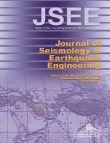فهرست مطالب

Journal of Seismology and Earthquake Engineering
Volume:24 Issue: 3, Autumn and Summer 2022
- تاریخ انتشار: 1402/10/27
- تعداد عناوین: 4
-
-
Pages 1-10Essentially, assuming a simple fault model, the hypocenter and centroid should be located on the same plane. This approximation can help to distinguish the fault plane from the auxiliary plane of an earthquake in many situations. On April 5, 2017, the Sefidsang earthquake Mw 6 occurred in north-eastern Iran. It was not possible to relate a fault to the earthquake according to the reports of the Iranian seismological center (IRSC) and the International Institute of earthquake engineering and seismology (IIEES) of Iran. The association of the earthquake to the western part of the Fariman fault or to the southern end of the Kashfroud fault is not possible. In this study, data from the stations of the aforementioned agencies was used to model the earthquake waveforms, and an effort was made to find the focal mechanism of this earthquake, investigate it, and also to eliminate the ambiguities that exist in determining the fault plane of the earthquakes using the Hypocenter-Centroid (H-C) method, due to the higher accuracy in simulating the waveforms and finding the centroid point of earthquakes in local and regional distances. we obtain the fault plane with a strike of 324 and dip of 44 degrees, which indicates the northwest-southeast trend, parallel to the trend of the Kashfroud fault. This has good agreement with the results of other researchers.Keywords: H-C Method, Focal mechanism, Kashafroud fault, ISOLA
-
Pages 11-23Due to the importance of buried pipelines, as one of the types of lifelines, it is necessary to consider all possible seismic hazards in their operation. Settlement and lateral spreading caused by liquefaction are among these risks. In this research, their effects have been investigated using two series of 1-g shaking table tests. Results show that the maximum displacement applied to the pipe occurs during the shake is greater than the residual displacement after the shake. Also, by investigating the shear stress-shear strain curves (hysteresis loop), the reduction of shear stiffness due to the shake was observed. After liquefaction occurs, the soil loses its shear strength and the slope starts to move downstream. It is observed that the contribution of cyclic strains due to ground vibration is far less than the contribution of strain due to monotonic displacement. According to the findings of this research, the deformation of the pipe is less than the settlement of the ground due to the liquefaction.Keywords: Buried Pipeline, Liquefaction, Settlement, Lateral Spreading, 1-g shaking table
-
Pages 25-38One of the important factors in determining the response of the structures is the correct evaluation of the input motion. This input excitation can be affected by various factors such as the propagation of waves in different layers, site effects, interaction of soil-structure, etc. Another problem with the numerical analysis is the use of appropriate absorbing boundaries to prevent the return of scattered waves into the analysis environment. Besides, the non-linear behavior of construction materials can also change the propagated waves, which makes the problem more complicated. One of the simple methods to estimate the nonlinear behavior of materials is to use the equivalent linear analysis method, which is still used due to its simplicity and ease of use. In this research, by preparing the finite element time domain dynamic analysis code using C programming language, the response of the free field, which is the first step in estimating the soil-structure interaction effect, has been evaluated using the equivalent linear analysis method. In addition, to increase the accuracy of the results, radiation damping simulation by perfectly matched layers (PML) has been implemented. This program uses four-nodded quadrilateral elements and the implicit Newmark method to solve the dynamic equation. For using PML in the equivalent linear method, the PML properties were updated based on adjacent elements to avoid reflection from boundaries. The results showed that the nonlinear behavior of materials can change responses significantly in a way that it be far away from results of the linear analysis. Furthermore, the results showed that the procedure adopted to perform equivalent linear analysis using PML is efficient.Keywords: wave propagation, Perfectly Matched Layer, Free-Field, equivalent linear, IDAMP
-
Pages 39-59Time history analysis of structures require some carefully selected earthquake records to be employed as the input for dynamic analysis. Despite the increase in number of recorded earthquake ground motions, the need for generation of artificial accelerograms are highly demanded in some areas for some reasons. As a result, many efforts have been made to develop mathematical methods for simulating ground motions by various researchers. Since most of the methods for generation of spectrum compatible signals use relatively complex mathematical approaches, it requires engineers to make more effort and spend time to deal with these complicated methods. In order to meet engineers’ demand for generation of the above-mentioned signals while maintaining an applicable tool that is easy to utilize, a simple, numerically iterative novel procedure has been proposed which is based on linear combination of intrinsic mode functions (IMF) of recorded seismic signals evaluated by empirical mode decomposition (EMD). The proposed method requires only basics of structural dynamics and definitely all engineers are familiar with them and simply can apply the method, while it leads to results as accurate and efficient as benchmark methods such as random vibration theory and time-frequency analysis techniques. The results of this study prove the applicability of the developed approach.Keywords: Ground motion simulation, Empirical Mode Decomposition, over-determined system of equations


